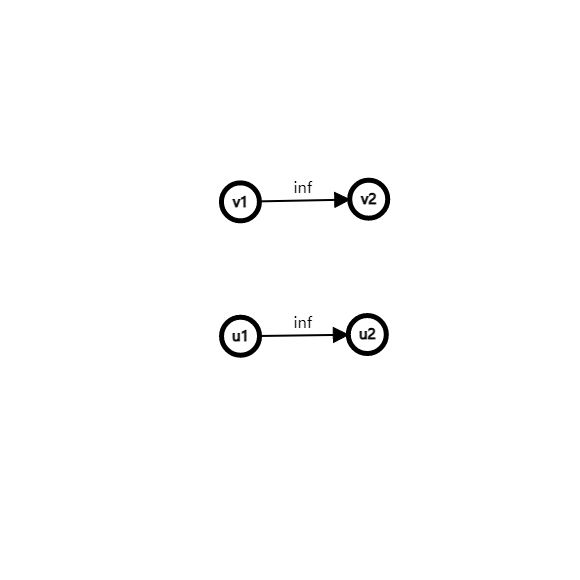题目
点这里看题目。
分析
建图有两个重要的条件需要注意:
- 弹道可能变成了折线;
- 控制每个格子最多被穿过一次;
常规的最大流/费用流做法不方便处理第一个点,我们不妨尝试最小割。
第二个点就意味着,每个格子要么被纵向穿过,要么被横向穿过。此时每个格子就存在两种选择,恰好对应 " 属于 (S) " 和 " 属于 (T) " 两种情况。
那么进一步思考,最小割的初始值是多少?当然是每个箭塔的攻击方向上的最大分值。
取到最大分值的要求是,路径上的格子都要被箭矢的方向穿过,中途有一格断了都不行。于是可以考虑对攻击路线上的所有格子设置边的代价。
考虑攻击方向上的格子 (u) 和下一个格子 (v) ,应该如何限制。首先我们已经有了基本图:

考虑,如果 (u_1) 选择在 (S) 集合,我们就认为它是纵向穿过,否则是横向穿过。现在有一支箭矢纵向穿过,那么 (u_1) 属于 (S) 集合,而 (v_1) 属于 (T) 集合时,这只箭就无法射出,我们需要计算代价 (w) ,接着连接 (u_1 ightarrow v_1) ,容量为 (w) ,表示必须要花费这样的代价。注意,如果 (u) 上面本身就有一个箭靶,我们应该计算它带来的贡献。
对于一个纵向的箭塔 (u) ,它必须属于 (S) 集合,因此连接 (S ightarrow u) ,容量为 (infty) 。同理,对于横向应连出 (v ightarrow T) ,容量为 (infty) 。
建完就可以开始跑最大流啦。
小结:
利用每个格子只能横向或纵向这样的选择,从而联系到了 " 属于 (S) " 和 " 属于 (T) " 两种情况;接着便可以利用二元关系建图。
代码
#include <cstdio>
#include <cstring>
const int INF = 0x3f3f3f3f;
const int MAXN = 1e6 + 5, MAXM = 1e6 + 5;
const int MAXS = 105;
template<typename _T>
void read( _T &x )
{
x = 0; char s = getchar(); int f = 1;
while( s < '0' || '9' < s ) { f = 1; if( s == '-' ) f = -1; s = getchar(); }
while( '0' <= s && s <= '9' ) { x = ( x << 3 ) + ( x << 1 ) + ( s - '0' ), s = getchar(); }
x *= f;
}
template<typename _T>
void write( _T x )
{
if( x < 0 ) putchar( '-' ), x = -x;
if( 9 < x ) write( x / 10 );
putchar( x % 10 + '0' );
}
template<typename _T>
_T MIN( const _T a, const _T b )
{
return a < b ? a : b;
}
template<typename _T>
_T MAX( const _T a, const _T b )
{
return a > b ? a : b;
}
struct Edge
{
int to, nxt, c;
}Graph[MAXM << 1];
int dir[4][2] = { { -1, 0 }, { 1, 0 }, { 0, -1 }, { 0, 1 } };
char tower[256];
int q[MAXN];
char S[MAXS][MAXS];
int head[MAXN], dep[MAXN], cur[MAXN];
int N, M, cnt = 1, tot;
void AddEdge( const int from, const int to, const int C )
{
Graph[++ cnt].to = to, Graph[cnt].nxt = head[from];
Graph[cnt].c = C, head[from] = cnt;
}
#define In( x, y ) ( ( x - 1 ) * M + y )
#define Out( x, y ) ( ( x - 1 ) * M + y + N * M )
bool Inside( const int x, const int y ) { return 1 <= x && x <= N && 1 <= y && y <= M; }
void AddE( const int from, const int to, const int C ) { AddEdge( from, to, C ), AddEdge( to, from, 0 ); }
bool BFS( const int S, const int T )
{
int h = 1, t = 0, u, v;
for( int i = 1 ; i <= tot ; i ++ ) dep[i] = INF;
dep[q[++ t] = S] = 0;
while( h <= t )
{
u = q[h ++];
for( int i = head[u] ; i ; i = Graph[i].nxt )
if( Graph[i].c && dep[v = Graph[i].to] > dep[u] + 1 )
dep[q[++ t] = v] = dep[u] + 1;
}
return dep[T] < INF;
}
int DFS( const int u, const int lin, const int T )
{
if( u == T ) return lin;
int used = 0, ret, v, c;
for( int &i = cur[u] ; i ; i = Graph[i].nxt )
{
v = Graph[i].to, c = Graph[i].c;
if( dep[v] == dep[u] + 1 && c && ( ret = DFS( v, MIN( lin - used, c ), T ) ) )
{
used += ret, Graph[i].c -= ret, Graph[i ^ 1].c += ret;
if( used == lin ) break;
}
}
if( used < lin ) dep[u] = INF;
return used;
}
int Dinic( const int S, const int T )
{
int f = 0;
while( BFS( S, T ) )
{
for( int i = 1 ; i <= tot ; i ++ ) cur[i] = head[i];
f += DFS( S, INF, T );
}
return f;
}
int main()
{
memset( tower, -1, sizeof tower );
tower['A'] = 0, tower['V'] = 1, tower['<'] = 2, tower['>'] = 3;
read( N ), read( M ), tot = ( N * M ) << 1;
const int s = ++ tot, t = ++ tot; int ans = 0;
for( int i = 1 ; i <= N ; i ++ ) scanf( "%s", S[i] + 1 );
for( int i = 1 ; i <= N ; i ++ )
for( int j = 1 ; j <= M ; j ++ )
{
int d;
AddE( In( i, j ), Out( i, j ), INF );
if( ~ ( d = tower[S[i][j]] ) )
{
int x, y, val = 0;
if( d < 2 ) AddE( s, In( i, j ), INF );
else AddE( Out( i, j ), t, INF );
for( x = i, y = j ; Inside( x, y ) ; x += dir[d][0], y += dir[d][1] )
if( '0' <= S[x][y] && S[x][y] <= '9' ) val = MAX( val, S[x][y] - '0' );
ans += val, x = i + dir[d][0], y = j + dir[d][1];
if( Inside( x, y ) )
{
if( d < 2 ) AddE( In( i, j ), In( x, y ), val );
else AddE( Out( x, y ), Out( i, j ), val );
for( ; Inside( x + dir[d][0], y + dir[d][1] ) ; x += dir[d][0], y += dir[d][1] )
{
int coe;
if( '0' <= S[x][y] && S[x][y] <= '9' ) coe = val - S[x][y] + '0';
else coe = val;
if( d < 2 ) AddE( In( x, y ), In( x + dir[d][0], y + dir[d][1] ), coe );
else AddE( Out( x + dir[d][0], y + dir[d][1] ), Out( x, y ), coe );
}
}
}
}
write( ans - Dinic( s, t ) ), putchar( '
' );
return 0;
}